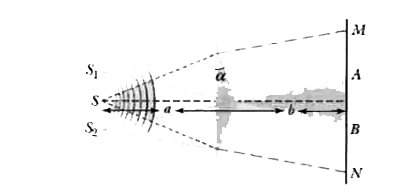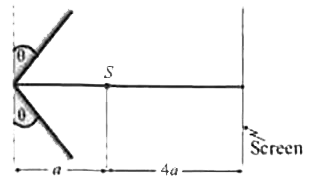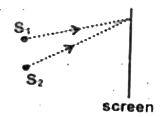Light from source S is incident on the Fresnel biprism shown in Figure. The light beams refracted by the different faces of the prism partly overlap and produce an interference pattern on a screen on its section AB.

How many interference fringes can be observed on a screen?
KEY IDEA
N=L/β, where L is the width of the interference pattern.
Calculation: It can be seen that AB=(b/a)d where d is the distance between the virtual images S1 and S2 of the source. So, we get
N=4abα2(n−1)2(a+b)λ≅5
Topper's Solved these Questions
- BOOK - RESNICK AND HALLIDAYCHAPTER - INTERFERENCE AND DIFFRACTION EXERCISE - CHECKPOINT6videos
INTERFERENCE AND DIFFRACTION
- BOOK - RESNICK AND HALLIDAYCHAPTER - INTERFERENCE AND DIFFRACTION EXERCISE - PROBLEMS61videos
INTERFERENCE AND DIFFRACTION
- BOOK - RESNICK AND HALLIDAYCHAPTER - HYDROGEN ATOMEXERCISE - PRACTICE QUESTIONS(Integer Type)6videos
HYDROGEN ATOM
- BOOK - RESNICK AND HALLIDAYCHAPTER - MAGNETIC FIELDS DUE TO CURRENTSEXERCISE - Practice Question (Integer Type)4videos
MAGNETIC FIELDS DUE TO CURRENTS
Similar Questions
Knowledge Check
- Question 1 - Select One
Two coherent sources of light interfere and produce fringe pattern on a screen . For central maximum phase difference between two waves will be
AzeroBπC3π2Dπ2 - Question 2 - Select One
Two coherent sources of light interfere and produce fringe pattern on a screen . For central maximum phase difference between two waves will be
AπB3π/2Cπ/2DZero - Question 3 - Select One or More
An interference pattern is formed on the screen, when light from two different monochromatic sources are allowed to interfere. Then, it is true that
AFrequencies of light from the two sources are equal to each otherBThe sources are coherentCThe sources should be located in the same mediumDThe path difference should either be an even or an odd multiple of λ/2, where λ is the wavelength of light
The two slits in Young's double slit experiment are illuminated by two different sodium lamps emitting light of the same wavelength. No interference pattern will be observed on the screen.
View SolutionThe two slits in Young's double slit experiment are illuminated by two different sodium lamps emitting light of the same wavelength. No interference pattern will be observed on the screen.
View SolutionIn Young's double-slit experiment,, monochromatic light of wavelength 630 nm illuminates the pair of slits and produces an interference pattern in which two consecutive bright fringes are separated by 8.1mm. Another source of monochromatic light produces the interference pattern in which the two consecutive bright fringes are separated by7.2 mm. find the wavelength of light from the second source.
What is the effect on the interference fringes if the monochromatic source is replaced by a source of white light ?View SolutionThere are two plane mirrors. They are mutually inclined as shown in figure. S is a source of monochromatic light of wavelength λ. The reflected beam interfere and fringe pattern is obtained on the screen. If θ is small, the fringe width will be :
 View Solution
View SolutionA monochromatic light source S of wavelength 440 nm is placed slightly above a plane mirror M as shown . Image of S in M can be used as a virtual source to produce interference fringes on the screen. The distance of source S from O is 20.0 cm, and the distance of screen from O is 100.0 cm (figure is not to scale). If the angle θ=0.50×10−3 radians, the width of the interference fringes observed on the screen is –
 View Solution
View Solution


